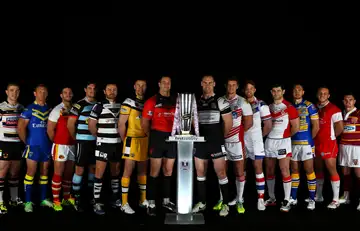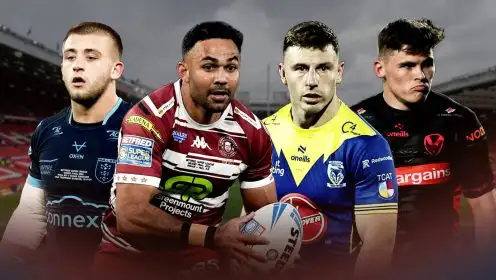Rugby League Week #24: Stats entertainment

As some notable worthy once said: there are lies, damned lies and statistics. No doubt he or she did so having read the latest upbeat RFL press release.
Actually, I think it was Mark Twain, though as he’s been credited with just about every quote since the dawn of civilisation it wouldn’t surprise me if he’d been held responsible for ‘Wide to West’ too at some point, so it’s best to hold fire on that.
Anyway, I was reminded of the phrase this week when, as usual, the most useful RFL press release by far dropped with a ping into my inbox.
Its name is In Touch which, if you’re not familiar with it, is a round robin ‘factsheet’ sent to members of the media with all the information and stats that any RL journalist or broadcaster could need ahead of that weekend’s games.
Compiled by my old League Express chum Danny Spencer – truly one the league media’s most unsung Trojans – and the equally committed Ray Fletcher before him, In Touch is an absolute boon.
And yet I do wonder how much more could be made of it and, in fact, the antipathy of the game’s supporters to the idea of any statistical analysis at all.
The NFL has been reiterating its focus on London this week, confirming a ten-year deal to stage at least two games a year at the new home of Tottenham Hotspur from 2018, along with its current Wembley activity.
Just reading about that was a reminder that a season that seems to take up so little of the year – unlike our own marathon stint – is again almost upon us.
Their Hall of Fame pre-season game between Pittsburgh Steelers and Minnesota Vikings is only about three weeks away in fact, with the season proper kicking off four weeks after that, in early September.
I mention the NFL simply because if there was ever a sport in which player and team statistics are not only, ahem, utilised but pored over eagerly and cherished, it is this multi-million dollar entertainment machine.
Contrast that with rugby league, where the moment poor old Phil Clarke dares to suggest that there may be some sort of pattern here that goes beyond players ‘putting their body on the line’ he is howled down as some sort of nut.
And yet while admittedly only telling part of the truth, statistics can tell us so much about what is actually going on. Applied correctly, they can strip away bias, misinformation and preconceptions and lay the reality bare.
That second-rower you say is a lazy so-and-so? He put in seventy-five tackles last week. That half-back who never makes a break? He’s made nearly 3,000 metres so far this season. And so on.
I notice Stevo was using statistical evidence on Boots N’ All this week, to back up his argument that the game ought to get rid of scrums. “People say that because 12 players (six from each side) are involved,” he said, “there should be plenty of space to take advantage of and score some tries off the back of the scrum. The stats don’t lie and the scrum produces just two per cent of tries!”
So there you have it. What you do with that input, of course, is up to you, but at least your choice will be informed.
But over and above all that, there is the fact that stats can add both to the fun and understanding of what we are seeing on the field. In league, they are an under-used marketing tool that could be used to ramp up anticipation.
Thanks to Danny boy’s hard work, here are just a few of the personal and team milestones you might care to watch out for in round 22.
Saints have won on their last four visits to Warrington; Salford have lost their last 13 meetings with Leeds, for whom Zak Hardaker has scored a try in each of the last four of those games.
Ahead of what might be a crucial Hull derby, Leon Pryce needs just one appearance to reach 500 for his career, while Salford’s Luke Menzies and Castleford’s Lee Jewitt need one apiece for 150.
If Rob Burrow gets a hat-trick on Friday, he will have scored 200 tries in his career, while Michael Shenton needs two for 150. Leroy Cudjoe, Jon Wilkin and Danny Tickle all need one try apiece for a career century of touchdowns; Jordan Turner needs two and Paddy Flynn three.
If Cudjoe bags three points against Catalans – three drop-goals maybe (!) – he will have hit 500 for Huddersfield. And in the Championship, Scott McAvoy needs one appearance to reach 200 for Whitehaven, while Forty20’s own Luke Ambler is one away from 100 with Halifax, waiting for a return from injury.
There are several interesting Super League competition milestones too.
Andy Lynch needs one game to draw level with Keith Senior, who is currently in fifth place in the list of all-time leaders for most appearances with 413. In the list of all-time leading try scorers, Kirk Yeaman needs one try to draw level with Ade Gardner in eighth place on 153.
Danny Tickle, again, needs 13 points to reach Sean Long in fifth place on 2,200 in the list of all-time leading point-scorers, while Leeds boast the current leaders of each of those three tables with Kevin Sinfield (444 appearances), Danny McGuire (224 tries) and Sinfield again (3,358 points).
Castleford winger Denny Solomona, meanwhile, has scored tries in each of the Tigers’ last six matches, but London Broncos’ Wes Naiqama has the game’s current longest scoring streak, having registered points in the last 22 matches. In fact, Naiqama has scored in every Broncos game in 2015, his run beginning with a try and three goals in a win against Doncaster in February.
Remarkably, I think, consistency seems to be an issue across the divisions, with Halifax the most consistent in having won their last seven games, followed by Leigh and Oldham with five and North Wales with four.
Or perhaps such unpredictability ought instead to be celebrated; you reads your stat you takes your choice.
Hunslet, conversely, have lost their last eight games while Hemel have lost their last five.
And finally, Mose Masoe has Super League’s current longest run of consecutive appearances with 53, the human wrecking ball having debuted from the bench in Saints’ 38-18 win over Hull KR at Langtree Park in March 2014. He has been ever-present since.
Running Masoe close are Elliott Whitehead with 41 for Catalans, while Paul Aiton, Chris Hill and Jermaine McGilvary are on 37 each for Leeds, Warrington and Huddersfield respectively.
Well, I find all of that interesting. And perhaps the wider public would too if more of a fuss was made of it.
That’s all folks. Owing to an incoming deluge of work and other obligations, this will be the final ‘Rugby League Week’ column of 2015.
As the Super 8s hove into view, there is a sense that much of what they promised is already being delivered. At a stage in the season where, previously, the greater part of all three divisions might now be looking at their watches and wanting to get home to their pyjamas, a glass of chocolate stout and a good book, the excitement is mounting over what may lie ahead.
Well, it is for we hardy few who are already aware of rugby league’s charms. The battle is still to be won re catching the attention of the wider public – though maybe over the weeks to come the Super 8s and eventually Grand Final can come through on that front too. Let’s hope so.
Rugby league in this country stands on the cusp of greatness, obscurity or complete demise. No one knows which, whatever they tell you. Much will depend on the quality of administration, which was ever the case though in the world in which we now find ourselves, the game is squeezed on all sides like never before.
It certainly doesn’t help when we wilfully shrink, short-sighted attitudes towards the value of ‘A’ team football being a prime example of that.
These are dangerous times to celebrate a 120th birthday, but they are also brimming with amazing potential, especially given a newly enlightened attitude towards the importance of the international element down under.
That said, when you read quotes such as the following by NRL head of football Todd Greenberg you do have to wonder whether that ambition might not just stall on insularity.
“We are trying to ensure the ball is in play for longer because ultimately that is what fans want to see,” he said, in reference to the latest unilateral change in goal-line drop-out rules next year.
“They want to see football being played and not players standing around.”
I’ve no doubt a lot of league fans would agree with that, but such natural pauses in play do not seem to bother supporters of more popular, wealthy and widespread sports as soccer, cricket, tennis, golf, F1 motor racing, union and, yes, the good old ‘stop start’ NFL do they?
Breaks in play not only give players time to catch a breather, they allow the viewer to have one too. They give you time to think about what you have just seen, the better to understand tactics and work out what might happen next. Or if you are watching at home, pop the kettle on or grab a beer from the fridge.
They allow you to notice and mull over a game’s more subtle elements, to consider who is playing well and who is not, and crank up the appreciation of truly great passages of play when a match bursts suddenly into life.
Full on eighty-minute ‘action’ merely serves to make the sensational mundane. And carrying on with that action while a player lays injured on the ground, say, runs the risk of making rugby league appear uncivilized too.
But there are opportunities also. A few more sensible tweaks to the rules (agreed upon and brought in worldwide), a bit of futuristic vision matched with good old-fashioned pragmatism (see the Super 8s themselves for evidence of that), encouragement for those fledgling countries who seem to be springing up in all manner of unexpected locations, the promotion of that which is valuable and who knows what heights the game might reach in a relatively swift period.
Whatever fate has in store, the important thing is to enjoy rugby league in the here and now, without taking for granted the magnificent entertainment this sport so reliably provides. I refer my learned friends, to Nathan, er, Friend.
As with most things in life, it’s a matter of finding balance.
So here’s to a brilliantly competitive last third of the season marked by packed grounds, great TV and radio audience figures and a first class England–New Zealand Test series after that.
And as for those Super, Middle and After 8s, may the best teams go up or stay up, the worst teams go down and can someone please turn the volume down on the referees’ microphones or switch them off entirely?
Moooove!
Tone’s Tips: Victories for Warrington, Hull KR, Leeds, Wigan, Catalans and Castleford. Venue for Magic Weekend 2016 announced as Pluto.



